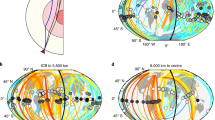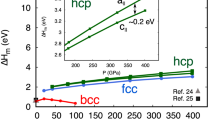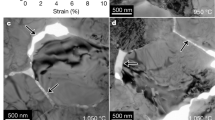Abstract
Elastic anisotropy in the Earth's inner core has been attributed to a preferred lattice orientation1, which may be acquired during solidification of the inner core2 or developed subsequent to solidification as a result of plastic deformation3,4,5. But solidification texturing alone cannot explain the observed depth dependence of anisotropy6,7,8, and previous suggestions for possible deformation processes have all relied on radial flow, which is inhibited by thermal9 and chemical stratification10. Here we investigate the development of anisotropy as the inner core deforms plastically under the influence of electromagnetic (Maxwell) shear stresses. We estimate the flow caused by a representative magnetic field using polycrystal plasticity simulations for ε-iron, where the imposed deformation is accommodated by basal and prismatic slip11. We find that individual grains in an initially random polycrystal become preferentially oriented with their c axes parallel to the equatorial plane. This pattern is accentuated if deformation is accompanied by recrystallization. Using the single-crystal elastic properties of ε-iron at core pressure and temperature12, we average over the simulated orientation distribution to obtain a pattern of elastic anisotropy which is similar to that observed seismologically13,14.
This is a preview of subscription content, access via your institution
Access options
Subscribe to this journal
Receive 51 print issues and online access
$199.00 per year
only $3.90 per issue
Buy this article
- Purchase on Springer Link
- Instant access to full article PDF
Prices may be subject to local taxes which are calculated during checkout



Similar content being viewed by others
References
Song, X. Anisotropy of the Earth's inner core. Rev. Geophys. 35, 297–313 (1997).
Bergman, M. I. Measurements of elastic anisotropy due to solidification texturing and the implications for the Earth's inner core. Nature 389, 60–63 (1997).
Wenk, H.-R., Baumgardner, J. R., Lebenshon, R. A. & Tomé, C. N. A convective model to explain anisotropy of the inner core. J. Geophys. Res. 105, 5663–5677 (2000).
Yoshida, S., Sumita, I. & Kumazawa, M. Growth model of the inner core coupled with the outer core dynamics and the resulting elastic anisotropy. J. Geophys. Res. 101, 28085–28103 (1996).
Karato, S. Seismic anisotropy of the Earth's inner core resulting from flow induced by Maxwell stresses. Nature 402, 871–873 (1999).
Song, X. & Helmberger, D. V. Depth dependence of anisotropy in Earth's inner core. J. Geophys. Res. 100, 9805–9816 (1995).
Creager, K. C. Large-scale variations in inner core anisotropy. J. Geophys. Res. 104, 23127–23139 (1999).
Garcia, R. & Souriau, A. Inner core anisotropy and heterogeneity level. Geophys. Res. Lett. 27, 3121–3124 (2000).
Yukutake, T. Implausibility of thermal convection in the Earth's solid inner core. Phys. Earth Planet. Inter. 101, 1–13 (1998).
Stacey, F. D. Theory of thermal and elastic properties of the lower mantle and core. Phys. Earth Planet. Inter. 89, 219–245 (1995).
Wenk, H.-R., Matthies, S., Hemley, R. J., Mao, H.-K. & Shu, J. The plastic deformation of iron at pressures of the Earth's inner core. Nature 405, 1044–1046 (2000).
Steinle-Neumann, G., Stixrude, L., Cohen, R. E. & Gülseren, O. Elasticity of iron at the temperature of the Earth's inner core. Nature 413, 57–60 (2001).
Creager, K. C. Anisotropy of the inner core from differential travel times of the phases PKP and PKIKP. Nature 356, 309–314 (1992).
Tromp, J. Support for anisotropy of the Earth's inner core from free oscillations. Nature 366, 678–681 (1993).
Yoo, C. S., Akella, J., Campbell, A. J. & Mao, H.-K. Phase diagram of iron by in situ x-ray diffraction: Implications for Earth's core. Science 270, 1473–1475 (1995).
Stixrude, L. & Cohen, R. E. High-pressure elasticity of iron and anisotropy of Earth's inner core. Science 267, 1972–1975 (1995).
Mao, H. K. et al. Elasticity and rheology of iron above 220 GPa and the nature of the Earth's inner core. Nature 396, 741–743 (1998).
Glatzmaier, G. A. & Roberts, P. H. Rotation and magnetism of Earth's inner core. Science 274, 1887–1891 (1996).
Buffett, B. A. & Bloxham, J. Deformation of Earth's inner core by electromagnetic forces. Geophys. Res. Lett. 27, 4001–4004 (2000).
Buffett, B. A. Geodynamic estimates of the viscosity of the Earth's inner core. Nature 388, 571–573 (1997).
Molinari, A., Canova, G. R. & Ahzi, S. A self-consistent approach of the large deformation polycrystal viscoplasticity. Acta Metall. 35, 2983–2994 (1987).
Lebensohn, R. A., Wenk, H.-R. & Tomé, C. N. Modelling deformation and recrystallization textures in calcite. Acta Mater. 46, 2683–2693 (1998).
Wenk, H.-R. & Tomé, C. N. Modeling dynamic recrystallization of olivine deformed in simple shear. J. Geophys. Res. 104, 25513–25527 (1999).
Wenk, H.-R., Matthies, S., Donovan, J. & Chateigner, D. BEARTEX, a Windows-based program system for quantitative texture analysis. J. Appl.Crystallogr. 31, 262–269 (1998).
Tanaka, S. & Hamaguchi, H. Degree one heterogeneity and hemispherical variation of anisotropy in the inner core from PKP(BC) - PKP(DF) times. J. Geophys. Res. 102, 2925–2938 (1997).
Vidale, J. S. & Earle, P. S. Fine-scale heterogeneity in the Earth's inner core. Nature 404, 273–275 (2000).
Singh, S. C., Taylor, M. A. J. & Montagner, J. P. On the presence of liquid in Earth's inner core. Science 287, 2471–2474 (2000).
Acknowledgements
We thank G. Steinle-Neumann for sending us a preprint of his work. B.A.B. was supported by NSERC, and H.R.W. acknowledges support from IGPP-LANL and NSF.
Author information
Authors and Affiliations
Corresponding author
Rights and permissions
About this article
Cite this article
Buffett, B., Wenk, HR. Texturing of the Earth's inner core by Maxwell stresses. Nature 413, 60–63 (2001). https://doi.org/10.1038/35092543
Received:
Accepted:
Issue Date:
DOI: https://doi.org/10.1038/35092543
This article is cited by
-
Superionic effect and anisotropic texture in Earth’s inner core driven by geomagnetic field
Nature Communications (2023)
-
Strength of iron at core pressures and evidence for a weak Earth’s inner core
Nature Geoscience (2013)
-
A new twist on inner-core spin
Nature Geoscience (2011)
-
Tectonic history of the Earth’s inner core preserved in its seismic structure
Nature Geoscience (2009)
-
Inner-core shear-wave anisotropy and texture from an observation of PKJKP waves
Nature (2008)
Comments
By submitting a comment you agree to abide by our Terms and Community Guidelines. If you find something abusive or that does not comply with our terms or guidelines please flag it as inappropriate.



